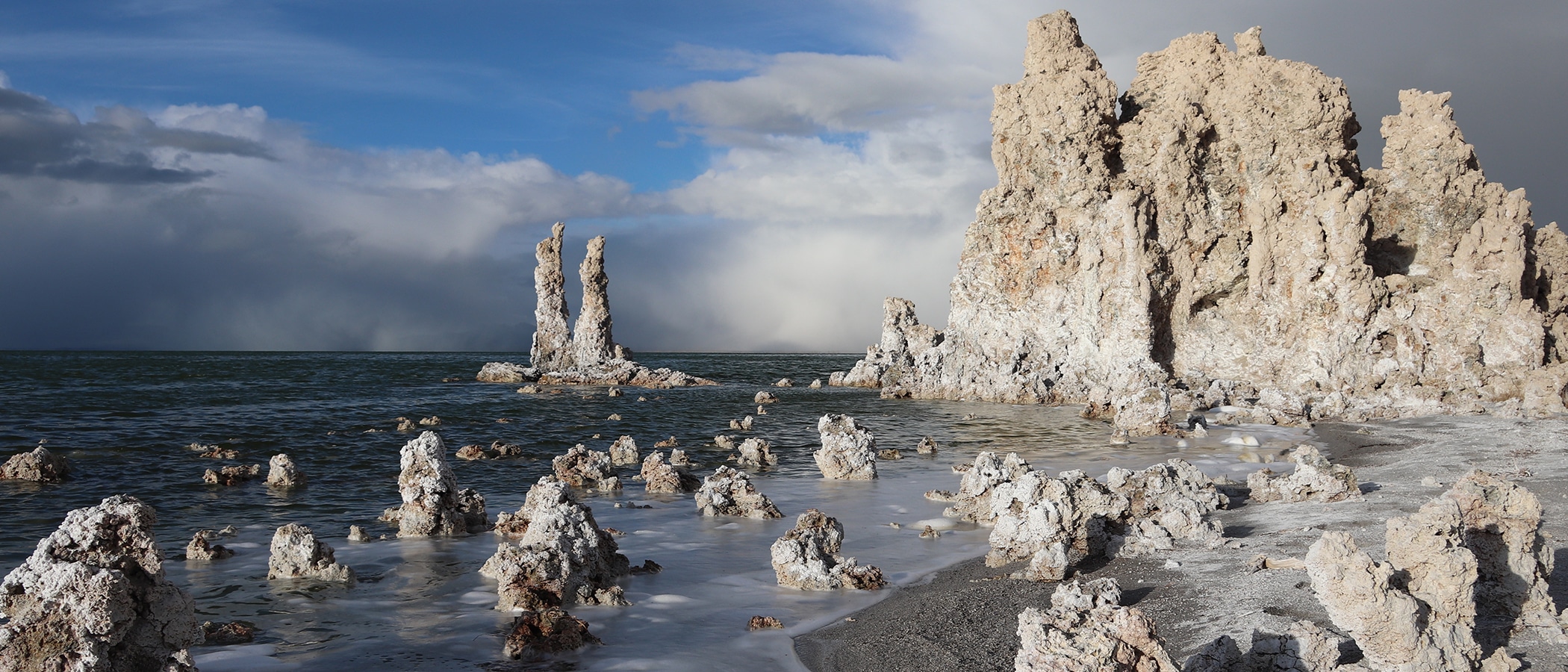
This essay, written by Karen A. Hegtvedt, appears in the 2022 Mono Lake Calendar.
Twenty-two (nonconsecutive) years of Mono Lake calendars sit on a shelf in the hallway closet. Over 264 visual reminders of the unique landscape of the Mono Basin—as it was and as it is becoming. Although I grew up on the west coast, I had never heard of Mono Lake until 1984 when I met attorney Patrick J. Flinn, then an associate at Morrison & Foerster working on a case for the National Audubon Society and the Mono Lake Committee. For the next 36 years of our personal “collaboration,” Pat regaled me with stories of the efforts to save and restore Mono Lake and its tributary streams.
Admittedly, I cannot recite the ordering of the various hearings intended to challenge the appropriation of water from the Mono Basin to serve the city of Los Angeles or which legal doctrine went with which hearing. I do recall sitting in Judge Terrence Finney’s courtroom one summer and hearing opposing counsel mention something about the “lifestyles” of brown trout. I have visited the area only a handful of times and our young adult children note that one of our failures as parents involved never taking them there (not fully true as we have photographic evidence of Patrick carrying our son as a toddler on his back at the lake shore). Nonetheless, Mono Lake became a touchstone for our Atlanta-based family life—not simply because the calendar adorned our kitchen wall yearly—but owing to the enduring collaborations it wrought.
During his years of legal practice, Patrick successfully litigated for many clients (largely regarding intellectual property), yet he remained “attached”—intellectually or emotionally—to only a few. Top among those was the Mono Lake Committee. The collaboration with environmental activists, scientists, and attorneys representing other interested parties expanded his knowledge and forged lifelong friendships. On our annual holiday visit to the Bay Area, all family members heard updates, often at length, on the progress of stream restoration from hydrologist extraordinaire, Peter Vorster. And Pat typically tried to arrange his demanding and travel-filled schedule to attend the Defense Trust weekend at Mono Lake.
In 2000, Patrick and I exemplified what had become our mutual attachment to the Mono Lake cause by collaborating on a publication that joined my expertise in the social psychology of justice and his in the litigation to ensure water flow into Mono Lake. Entitled Intergenerational Justice and the Environment: Determining the Fair Use of Mono Basin Water, we consider the historically situated “collaborations” that emerged to challenge the status quo of water diversions threatening the viability of the ecological treasure of the Eastern Sierra.
In the parlance of my discipline, we framed determination of the use of Mono Basin water in terms of justice (highlighting emphasis on collective welfare, not simply justified self-interest). We stressed power dynamics, conditions affecting goals and perceptions of individuals and groups, collective reactions to perceived injustice, and resolution of conflicting claims to ensure a just outcome that benefits current and future generations.
We connected these processes with the Mono Lake case, first delineating how Los Angeles came to claim water from the Mono Basin (yes, they seemed to follow the “rules” existing at the time to secure water rights, thereby implying fair use). We noted the rise of concerns about the consequences of water diversion for the ecosystem of the Mono Basin as well as the economy of its area (a collective reaction beginning as early as 1928, and later fueled by the advent of the ecological worldview in the 1970s stressing the balance between human societies and ecosystems despite limits on economic growth). We concluded by analyzing the ensuing litigation between (power-disadvantaged) environmental groups and the (power-advantaged) Los Angeles Department of Water & Power, as adjudicated by state institutions (State Water Resources Control Board and the courts).
The Mono Lake Committee legal team drew from long-standing laws, thus “collaborating” with prior lawmakers and parties with varying interests. They invoked the legal doctrine of the Public Trust, rooted in Roman law, which dictates that the state should act in the best interests of all beneficiaries equally regarding natural resources. They cited 1933 laws in the Fish & Game Code advocated by mountain counties and instituted to protect fisheries (and the fishing pleasure of the affluent tourists of the day). Even though the Public Trust doctrine explicitly anticipates intergenerational justice, the substantive limits it imposes on water rights were not well defined. Thus, court decisions on the application of the simpler allocation rules to protect fish ultimately ensured a rise in lake level and restoration of the ecosystem for future beneficiaries.
The collaborations inspired by the movement to “save” and then “restore” Mono Lake are many. Opposing sides in the earlier litigation even partnered to establish the Mono Basin Outdoor Education Center. In uniting underserved Los Angeles youth with the source of their water, the Center reinforces the collaborations necessary to meeting water needs of people and stewarding the vitality of the environment. Patrick’s contributions to the movement connect our family to a distinctive and now sustainable landscape hosting a unique and inspiring variety of plant and animal life. Mono Lake’s anticipated long life pays tribute to all those who collaborated to safeguard it.
Karen A. Hegtvedt is a Professor of Sociology at Emory University in Atlanta, Georgia. Her research has examined factors affecting perceptions of environmental injustice. She holds her late spouse, Patrick J. Flinn, accountable for her attachment to Mono Lake. Though they made a home in the land of dogwoods and magnolias, the values and vistas of the west colored their lives.
Top photo by Andrew Youssef.
